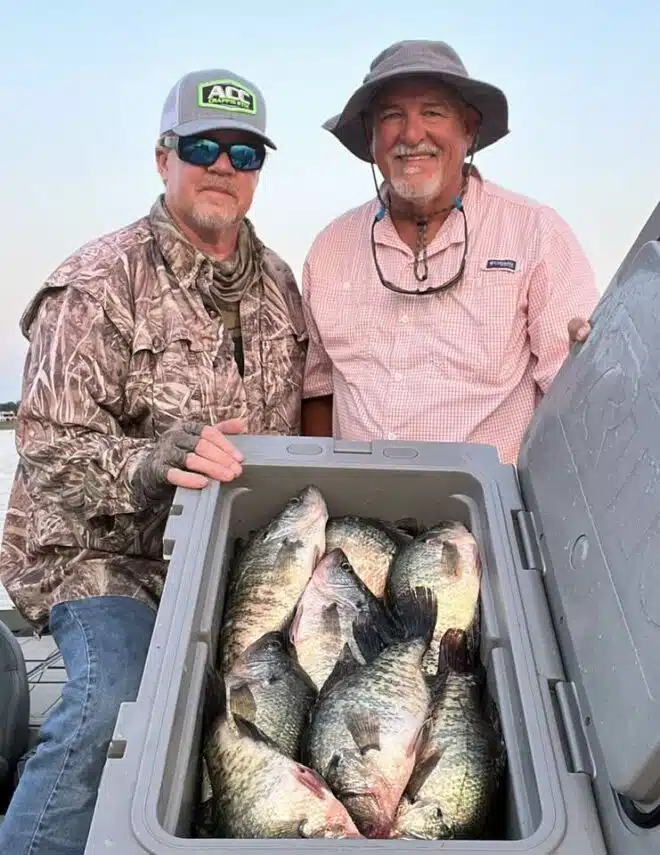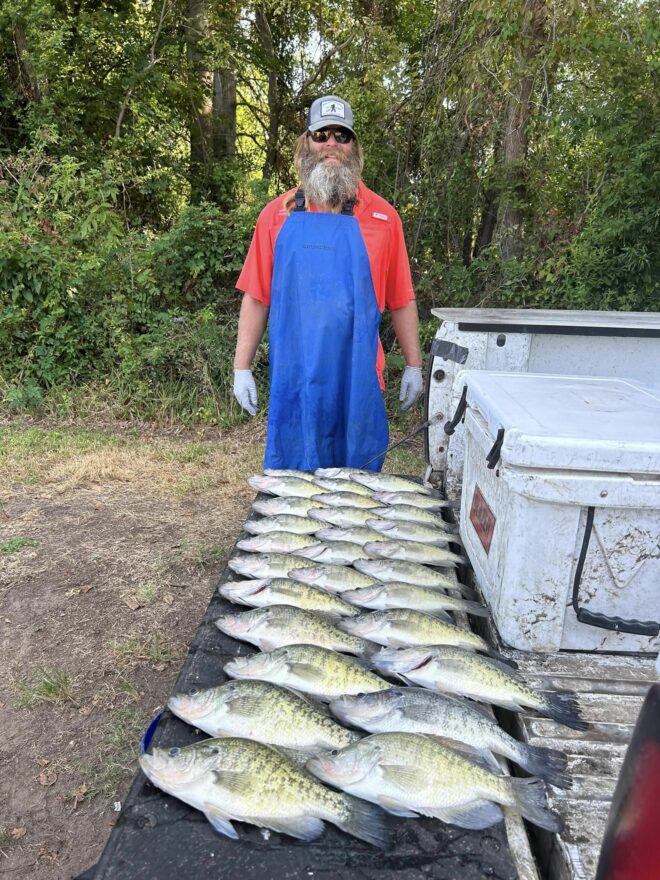Beat the heat for summer crappie

By Greg McCain
The recent heat wave sent the mercury soaring to triple digits across much of the country. In many situations, the heat actually appears to bother the fisherman more than the fish. Many guides report that the late-summer bite remains steady despite water temperatures well into the 90s on many lakes.
Just how do fishermen beat the heat when temperatures reach their peak in late summer? We asked members of the ACC Crappie Stix pro staff that question, and they responded with great ideas gleaned from experience on the water and in the elements. Many of them guide on a daily basis, and at least part of their livelihood means pushing through even the most difficult conditions. Some of the information focuses on the comfort of the fisherman while other tidbits will help put more crappie in the boat.
Many echoed similar ideas about hydrating and also starting early.
“I get out on the water at daylight, and I’m off by noon,” pro staffer Caleb Hensley said. “STAY HYDRATED. It’s not even a bad idea to go with a buddy. You never know what can happen in this heat, pass out, heat stroke, etc. You will have a buddy there to help.”
Caleb (903 Fishing on Facebook and other social media platforms) said his fish in the east Texas region are in typical summer patterns although at least some crappie hold in shallow water at times.
“Crappie are still in that 15-20 foot range for me, and they will be until December,” he said. “Not all crappie go deep in the summer. Some do, but not all. I focus on active fish in the summer. If you know there are fish there, and they aren’t biting, go find active fish that will bite. The more water you cover, the better chance of loading the boat.”
In Louisiana, pro staff member Wesley Miller (Big Sasquatch Outdoors on Facebook) endures the heat and guides clients to crappie almost on a daily basis, even in the hottest weather. He offers a couple of important suggestions to help put more summer slabs in the boat.
“Crappie are cold blooded, which means that their metabolism is based on water temperature, so the hotter the water the more often they have to feed,” Wesley said. “The only other part of that is that they’re going to expend as little energy as possible to do so. Therefore, it’s important to get your jig as close to the fish as you can to incite a bite. I’m also tipping my jigs with a pink crappie nibble. I think the sight of it and the smell helps.”

Other ACC Crappie Stix pro staffers offer other valuable suggestions about beating the heat and putting crappie in the livewell:
Fred Mooney (Full Moon Fishing Service on Facebook)
If I could guide at night right now, I surely would. My only major change is downsizing baits and tipping with a minnow. Location doesn’t change much on my waters. Start at daylight and be off by 10. I keep a fan on the front of the boat to help with the midges in stagnant air, and fish go straight to ice instead of the livewell.

Kennieth Pierce (Hook City TV on Facebook and YouTube)
Big Bill hats, long sleeve shirts, and a giant umbrella! Always hydrate the night before. A bottle of water every hour while fishing. Start early. Get off the water as early as possible.
Night fishing around lit docks is a great option for those who can’t stand the heat. Fish go directly on ice in the summer, especially if I plan to fish all day. As a rule of thumb, most folks look to the deep water and main river channels. But the shallows (3-8 feet) are not vacant! Texas has taught me a thing or two about summer crappie fishing.
Jonathan Phillips (Team Phillips Guide Service on Facebook)
River systems excel in hot temps.
Jeff Jowers (Southern Scales Guide Service, friend Jeff on Facebook for trip information)
Depending on where you fish and what species plays a role in how to deal with the heat and how they act. If it is somewhere like Grenada, I put up the Millennium umbrella. However here on my home waters (Coosa River) that’s not an option unless you plan on putting it up and down a hundred times a day. What I mean by that is when targeting black crappie in the dog days of summer you better be ready to make milk runs. Sure, you find many fish stacked up on structure such as standing timber, stumps, brush piles ect. However many fish aren’t willing to cooperate. I pick up the few that do and right after, pick-up that trolling motor and head to the next bundle. It does seem with the black fish they tend to feed better early. I usually start at daylight and hope (keyword “hope”) to have it quick and in a hurry.
As for fishing for the white fish, that’s a whole different animal. They seem to chew better the hotter it gets. Being that you don’t have to do a lot of moving, that umbrella saves the day in that situation.

Keith Acker (Friend Keith on Facebook for trip information)
The fish that I’ve been targeting have been in the same exact areas since the spawn. They are up on the flats. Most of the fish are in groups. They are not aggressive but will bite if you put the jig on their nose. I’ve been using the Gray Ghost colored hair jig because it is the most natural looking bait I’ve found.
The black crappie seem to bite better when it’s early/late or if they are around structure that provides coverage from the sun. The white crappie seem to bite best in the middle of the day if you can take the heat. Some of the fish want the bait dead still in front of them while others want it to pass right over their nose so we are mixing up our presentation depending on how each group of fish reacts.
Make sure you have plenty of ice in the cooler to keep your fish cool (I bring an extra cooler with ice in it during the summer). If you can take the heat, this is a good time of the year to fill the freezer as well as avoid all the boats.

Don McClish (PointBreak Crappie Guide Service on Facebook)
Along with staying hydrated and UV protected, I also consume salt tablets which helps with fatigue and cramping as for clients. I bring the umbrella and keep cool wraps on ice.
As for the fishing and with my lake having both dirty and clear water, I adjust accordingly to the area. The UV’s affects crappie more than water temps. Many times in the dirty water area, I’ve “doodlesock’d” crappie out of laydowns in 2′ of water with surface temps near a 100°. Also in the creek areas that have overhanging willows, I’ll “shoot the shade” with a blade head. In the clear water areas, I’m looking for the structure that provides the most UV protection whether it’s docks, Bois d’arc or thick cedars, regardless the depth of water.
The theory that put me on a shallow summer pattern in the early 90s was a day at the lake with the family. While out tooling around in the water and hitting those “cold” pockets I thought to myself, “they ain’t no reason why a crappie shouldn’t be up in this.” My next trip out I concentrated on nothing but shallow stuff 6′ or less and noticed the areas where I caught more fish in, their body temps were cooler than the stragglers I picked up here and there.
By the way, ice ice, baby. I fill my livewells with 40lbs of ice to keep the catch fresh.
Craig Nichols (follow The Crappie Cowboy Craig Nichols on Facebook)
Summertime for me is fishing shallow flats looking for any structure that will produce shade. I downsize my presentation and also use scent or minnows. I carry a battery operated fan in the boat for clients. Start early and try to be done before the hottest part of the day. I also immediately ice my fish down to keep them fresh and firm up the meat before cleaning.













